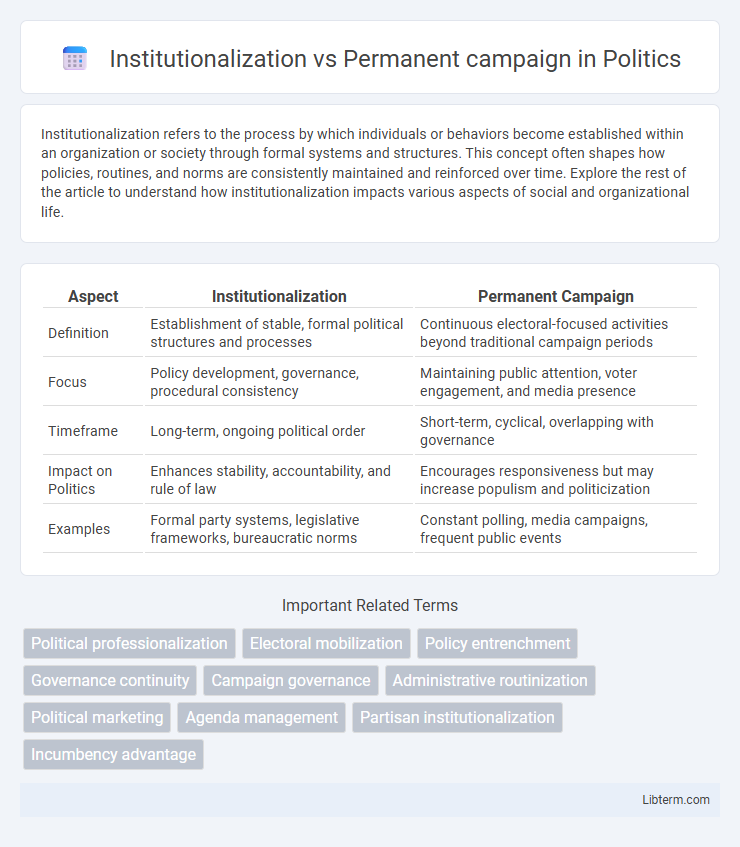Institutionalization refers to the process by which individuals or behaviors become established within an organization or society through formal systems and structures. This concept often shapes how policies, routines, and norms are consistently maintained and reinforced over time. Explore the rest of the article to understand how institutionalization impacts various aspects of social and organizational life.
Table of Comparison
| Aspect | Institutionalization | Permanent Campaign |
|---|---|---|
| Definition | Establishment of stable, formal political structures and processes | Continuous electoral-focused activities beyond traditional campaign periods |
| Focus | Policy development, governance, procedural consistency | Maintaining public attention, voter engagement, and media presence |
| Timeframe | Long-term, ongoing political order | Short-term, cyclical, overlapping with governance |
| Impact on Politics | Enhances stability, accountability, and rule of law | Encourages responsiveness but may increase populism and politicization |
| Examples | Formal party systems, legislative frameworks, bureaucratic norms | Constant polling, media campaigns, frequent public events |
Understanding Institutionalization in Politics
Understanding institutionalization in politics involves the process by which political practices, rules, and norms become stable, valued, and established within a political system. Institutionalization ensures continuity, predictability, and legitimacy in governance by embedding political behaviors into formal structures like parties, legislatures, and bureaucracies. This contrasts with the permanent campaign approach, which emphasizes constant electoral strategy over stable, rule-bound governance.
Defining the Permanent Campaign Phenomenon
The permanent campaign phenomenon refers to the continuous state of electioneering tactics employed by politicians even when not in active election cycles, blending governance with ongoing political strategy. Institutionalization emphasizes structured, rule-based systems within political entities, whereas the permanent campaign prioritizes adaptive, media-driven engagement aimed at maintaining public support and electoral advantage. This dynamic shifts political focus from policy implementation to sustained voter engagement and image management, fundamentally altering traditional governance approaches.
Historical Evolution: From Institutional Politics to Perpetual Campaigning
The historical evolution from institutional politics to perpetual campaigning reflects a shift in political strategy characterized by continuous electoral efforts rather than fixed governance terms. Institutionalization emphasized stable party structures and policy-making processes, while the permanent campaign prioritizes constant voter engagement through media and adaptive messaging. This transition marks a significant change in political dynamics, where campaigning techniques increasingly dominate political decision-making and governance.
Key Differences: Institutional Stability vs. Campaign Dynamism
Institutionalization ensures organizational stability by embedding processes and structures that endure while permanent campaigns prioritize continuous adaptation to maintain voter engagement and support. Institutional stability relies on consistent policies and institutional memory to guide long-term strategy, whereas campaign dynamism thrives on rapid response, constant messaging shifts, and agility in tactics. The key difference lies in how institutionalization favors sustained governance continuity, while permanent campaigns emphasize ongoing electoral competitiveness and momentum.
The Impact on Governance and Policy-Making
Institutionalization strengthens governance by embedding transparent procedures and stable frameworks that enhance policy continuity and accountability. Permanent campaigns often prioritize short-term electoral gains, which can lead to policy volatility and hinder long-term planning. The persistent focus on electoral strategies in permanent campaigns risks undermining institutional norms, affecting the effectiveness of governance and the formulation of coherent policies.
Media’s Role in Shaping the Permanent Campaign
Media plays a crucial role in shaping the permanent campaign by continuously framing political messaging through persistent coverage, which blurs the lines between governance and campaigning. The institutionalization of processes within political organizations contrasts with the media's preference for sensational and attention-grabbing content, reinforcing a cycle where officials remain in campaign mode to maintain favorable public perception. This dynamic amplifies the media's influence on public opinion, forcing politicians to prioritize short-term messaging strategies over long-term policy development.
Effects on Political Parties and Leadership
Institutionalization strengthens political parties by embedding structured rules, stable leadership, and clear ideological platforms, which fosters party cohesion and long-term voter loyalty. Permanent campaigns shift focus towards continuous electoral strategies, prioritizing short-term public opinion and media management over substantive policy development, often leading to weakened party structures and personalized leadership. This dynamic reduces party institutional strength while amplifying the influence of charismatic leaders and campaign professionals in shaping political agendas.
Public Perception and Voter Engagement
Institutionalization fosters consistent public trust through transparent governance and stable policy frameworks, enhancing long-term voter engagement by demonstrating accountability and reliability. Permanent campaigns prioritize continuous voter mobilization and media presence, which may increase short-term engagement but risk voter fatigue and skepticism due to perceived opportunism. Public perception shifts depending on the balance between stable leadership and relentless campaigning, influencing the efficacy of democratic participation.
Challenges and Criticisms of Each Model
Institutionalization faces challenges such as bureaucratic inertia and resistance to change, often leading to rigidity and inefficiency in adapting to new political environments. The permanent campaign model is criticized for prioritizing short-term electoral gains over long-term policy goals, resulting in constant fundraising pressures and campaign-focused decision-making. Both models struggle with balancing effective governance and political strategy, which can undermine public trust and democratic accountability.
The Future Path: Navigating Between Institutionalization and Permanent Campaign
Navigating between institutionalization and the permanent campaign requires balancing stable governance structures with ongoing political strategy to maintain power and influence. Institutionalization promotes durability and consistency in policies, while the permanent campaign emphasizes adaptability and continuous voter engagement. Future political success depends on integrating both approaches to foster resilient institutions without sacrificing responsiveness to public needs.
Institutionalization Infographic

 libterm.com
libterm.com